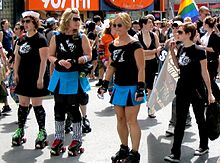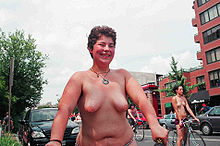- Dyke March
-
Dyke March is a mostly lesbian-led and inclusive gathering and protest march much like the original gay pride parades and marches. They usually occur the Friday or Saturday before LGBT pride parades and larger metropolitan areas have related events (parties, benefits, dances) both before and after the event to further develop community often targeting specific community segments (older women, bar events, arts, parenting groups, etc.) The purpose of a Dyke March is to increase lesbian visibility and activism and they have grown to be more inclusive of all women-loving-women regardless of labels as well as bisexuals, intersex and transgender persons.
Contents
Beginnings
One of the first documented lesbian pride marches in North America took place in May, 1981, in downtown Vancouver, B.C. Canada. The march, which attracted approximately 200 lesbians, was part of the Bi-National Lesbian Conference.[1] In October, 1981, an organization called Lesbians Against the Right organized a second march in Toronto, Ontario.[1]
The first U.S. nationwide Dyke March was held in Washington, D.C. on April 24, 1993.[2] This event was also planned by the Lesbian Avengers. Over 20,000 women marched at this event.[3][unreliable source?] The large turnout can be attributed to the fact that the Dyke March coincided with a larger march on Washington.
San Francisco
The first San Francisco Dyke March was held a few months later, in June 1993, and is still celebrated every year on the Saturday evening before the annual Pride Parade. The Dyke March is informal, with marchers creating their own signs and most people showing up to participate, rather than to just watch. The streets along the march route are lined with thousands of enthusiastic spectators, mostly gay men in support of the women. The march begins in Dolores Park with speeches, performances and community networking and ends in the Castro District, at the Pink Saturday party where the Dyke March sound-truck becomes a stage for more performances, DJs and more speakers.[citation needed] The San Francisco Dyke March has high attendance numbers yet remains a peaceful and well-organized event. While some have stated that 200,000 attend, the more common estimate for 2010 is around 50,000, as found on the official website.
Since its inception, the San Francisco Dyke March Committee (a small group of volunteers) has never applied for nor received a permit from the city, exercising the First Amendment right to gather without permits and without blatant corporate sponsorships.[4]
New York
New York City's Dyke March is another beloved tradition. In the 1970s, separate Lesbian Pride marches were held, for several years, but they did not become a continuous tradition. The Dyke March was renewed by the NY Chapter of the Lesbian Avengers in June 1993 (after the success of the Dyke March in Washington).
On the Saturday before Pride, lesbians gather in Bryant Park as they prepare to march down Fifth Avenue towards Washington Square Park.[citation needed] The Dyke March is open to all self-identified women. Because of this, men have been asked to stand on the sidewalks and cheer on the marchers. As with the San Francisco Dyke March, the organizers do not seek out a permit, and put a high emphasis on the political. Even though there are many club nights and parties after the March, the event is not so much about entertainment as it is about highlighting the presence of self-identified women within the LGBTQI community. Each year approximately 15,000 women attend this monumental event.
The reason for the creation of the various Dyke Marches was to protest what many women saw as the control of Gay Pride events by white gay men at the expense of lesbians in general and women of color in particular. Many of the Lesbian Avengers were also concerned that New York's Gay Pride March was losing its political edge as it became more accepted by the city and courted by corporations. They were also opposed to its associations with NAMBA.[citation needed]
Seattle
Seattle's Dyke March occurs the Saturday before Pride with a Rally with speakers and performers who are women identified and queer identified from 5 to 7pm. The Rally is held outside at Seattle Central Community College. The Rally is ASL interpreted. In addition to the speakers and performers, Northwest Network, an LGBTQ domestic violence organization, sets up a clothesline project, showcasing t-shirts made by survivors of domestic violence. The March goes through Seattle's LGBTQ neighborhood, going around a block starting and ending on Broadway, the center of the LGBTQ neighborhood.
For the better part of the last decade of Dyke March, organizers do seek a permit. Since about 2007, the march audience has been about 1,000 women, and the permit ensures the streets are clear for Marching. It also provides greater access an inclusion for the bus that is rented every year to allow differently-abled/disabled people to participate in the March.
Chicago
The Chicago Dyke March Collective occurs each year around the anniversary of the Stonewall riots, June 28, 1969. The Chicago Dyke March has been in operation since 1998 in the LGBQT-friendly neighborhood of Andersonville, however, in 2008 a decision was made to hold the Chicago Dyke March in a different neighborhood every summer. Organizers announced that the it will remain in each new location for two consecutive years. The March was held in Pilsen in 2009 and 2010. The March will take place in the neighborhood of South Shore in 2011. The March changes neighborhoods in an effort to bridge divides and combat stereotypes along race, class and geographic lines within the city’s lesbian and larger LGBTQ population.
The 2011 March route steps off near 71st and Jeffrey Boulevard and ends in Jackson Park and includes music, performances, and specified "safety zones" where volunteers and participants can gather. Local businesses and organizations cooperate with the March to provide participants with safety and support.
Dyke Marches are now held in Toronto, Montreal, Calgary, Ottawa, and Vancouver, Canada as well as Seattle, Philadelphia, Boston, Chicago, Washington, DC, Portland, ME, San Diego, Oakland,and other cities around the United States.
References
- ^ a b Bearchell, Chris (June 1981). "Lesbian Pride March is a First for Canada". The Body Politic.
- ^ "The Lesbian Avengers - DC". The Rainbow History Project. Retrieved January 7, 2010.
- ^ Belge, Kathy (2005). "Dyke March: Gay Pride's Lesbian Sister". About.com. Retrieved December 30, 2008.
- ^ Reisbig, Jeanine K. (September 2004). "Zesty fiesta of Lesbian Power, Political Commitment and Joy takes place June 26". San Francisco Spectrum. Retrieved December 30, 2008.
External links
- Boston Dyke March
- New York City Dyke March
- San Francisco Dyke March
- Santa Cruz Dyke March[dead link]
- Seattle Dyke March; http://www.facebook.com/pages/Seattle-Dyke-March/120795094608668?v=app_2373072738&ref=ts#!/pages/Seattle-Dyke-March/120795094608668; http://www.myspace.com/dykemarchseattle
- Toronto Dyke March
- Utah Dyke March
- Vancouver Dyke March
- Washington, D.C. Dyke March
- Portland, Maine Dyke March
- San Diego Dyke March
- Calgary Dyke March
Categories:- LGBT civil rights demonstrations
- Pride parades
- Lesbianism
Wikimedia Foundation. 2010.


